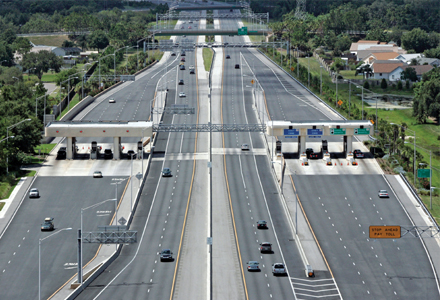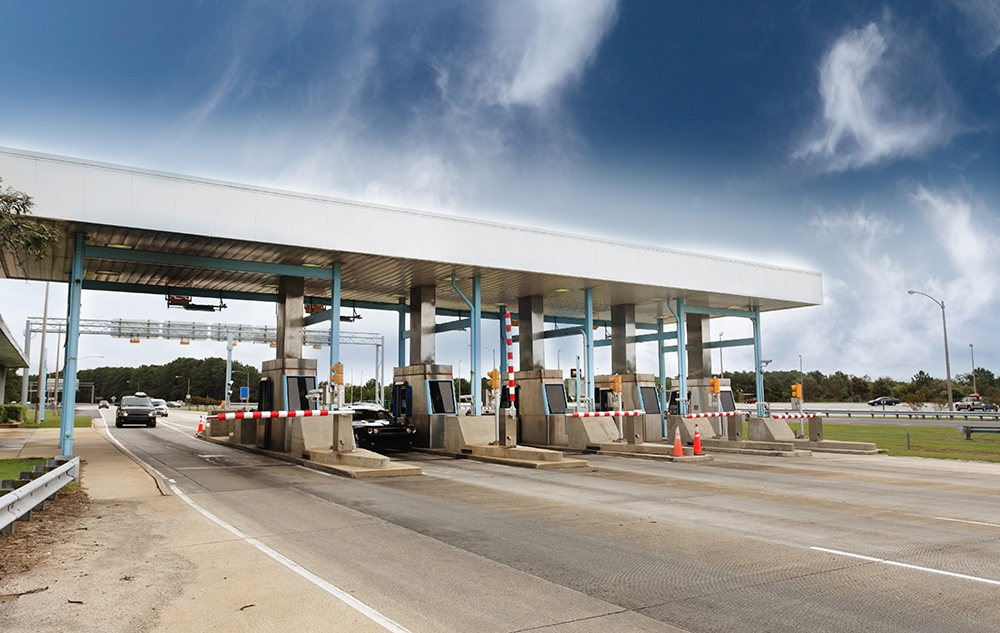How a temporary congestion-relief solution resulted in the North Texas Tollway Authority's transition to all-electronic toll collection and potential savings of up to $472 million by 2045. By Carla Kienast, ETC Corporation

Looking north from the Wycliff Plaza during construction. With many of the toll collection lanes closed, traffic snarled and congestion stretched for miles.
How a temporary congestion-relief solution resulted in the North Texas Tollway Authority's transition to all-electronic toll collection and potential savings of up to $472 million by 2045. By Carla Kienast, ETC Corporation
When in June 2006 the North Texas Tollway Authority (The DNT is a highly travelled, 32-mile, six-lane, limited-access expressway that funnels traffic from three North Texas counties to the business, government and entertainment destinations in downtown Dallas. The area served by the DNT includes some of the fastest-growing cities in the United States, and the region has experienced explosive growth since the first section of the DNT opened to traffic in June 1968.
The Wycliff Avenue mainline toll plaza at the southern terminus of the DNT, which processes an average of 2.3 million transactions per month, was part of the original section of toll road that opened approximately 40 years ago. By 2006, the toll plaza and its surrounding infrastructure were in need of significant improvements to support the ever-increasing traffic demands.
Congestion problems
Careful planning went into methods to minimise the project's impact on traffic. Nevertheless, on 21 December 2006 the southbound lanes were reduced to two cash and two electronic lanes. At that point, off-peak construction schedules and other efforts failed to offset the congestion. Northbound traffic was planned to be reduced to the same four-lane configuration in mid-January. Minor traffic accidents, exhaust emissions and drivers' frustrations increased while transactions declined as NTTA customers sought alternative routes.The NTTA responded quickly. Its first step was to analyse the situation to determine the actual cause of the congestion in order to devise an expedient and effective solution. Of the 1.1 million transactions NTTA collects each day, more than 80 per cent are collected electronically through the NTTA's TollTag(r) programme supported by the RITE(r) Solution end-to-end toll collection system. It became apparent the smaller percentage of cash-paying customers was the major cause of the issue.
Because there were only two lanes for cash collection, the slower, cash-paying vehicles often backed traffic past the access point that allowed TollTag users to enter the express lanes, especially at rush hour. The TollTag users were mired in the congestion with their cash-paying counterparts until they were able to inch forward far enough to enter the express lanes.
Eliminating cash transactions
Since adding more cash lanes was not feasible, it became apparent that to improve the flow of traffic through the Wycliff Avenue plaza the NTTA would have to eliminate cash collection altogether. However, removing cash collection meant that the only form of payment in the lane was electronic. This raised the issue of how to collect tolls from vehicles without TollTags. Without such an alternative, all vehicles without a TollTag would be treated as violators, which could result in potential customer service and public relations issues for the NTTA.The NTTA sought an innovative solution to the problem. It has a history of doing so. In 1989, for instance, the NTTA became the first authority to implement electronic toll collection on a toll road and subsequently deployed the first installation of 3+ lanes of open road tolling in the US. Coincidentally, the very first electronic transaction on a US toll road occurred on the DNT at the Wycliff Plaza, the focus of the current dilemma.
Seeking the optimal answer, NTTA staff worked closely with
The ZipCash video tolling solution
For vehicles without TollTags,Much had to be done to implement the new system, not the least of which were the legal and business issues to be resolved. Legal statutes had to be reviewed and decisions made about ZipCash rates and account parameters, as well as invoicing and collection processes.
To create the needed systems functionality, the NTTA created a focused ZipCash team. In the essence of time, and whenever possible, system modifications were being made in parallel with business-rule decisions. Images and data were collected from the lane, and a test environment was built. ZipCash had to work correctly or it could potentially cause another set of complex issues altogether. System and website features were rapidly designed and implemented to support the new customer service and violation requirements.
An important part of the process was communications. A focused and comprehensive plan was created for customers, employees and elected officials including news releases, in-lane signage, information on the NTTA's website, and via the NTTA's e-newsletter, Driving Forward. Information and training were developed for customer service representatives that would be working with the new system features and fielding calls from drivers receiving ZipCash invoices.
The final step in the process was receiving approval from the NTTA's board of directors to begin using the new system. This was unanimously granted during a special meeting on 30 January 2007 and less than two months after its conception ZipCash was ready to go live.
The same day it received board approval, the NTTA issued a news release announcing the launch of the new system. The release also underscored its intention that ZipCash was only a temporary solution specifically created to provide relief for drivers during the Wycliff Plaza improvement project. It would only be a matter of months before the NTTA reversed this position.
Immediate results
The results were immediate as traffic moved non-stop through the Wycliff Plaza and congestion diminished.Monitoring the effects of the new ZipCash system, the NTTA believed that there was much that could be gained by expanding AETC across the existing NTTA system as well as its several future projects.
There were many advantages to be considered. Customers benefitted from enhanced mobility and safety as well as improved air quality around the plaza. From a construction/capital standpoint, use of the all-electronic lanes increased the available work zone and on future projects, AETC would mean fewer construction stages, decreased construction time and fewer structures that needed to be built. Furthermore, AETC enabled the NTTA to fully utilise the roadway space and thereby maximise the throughput of vehicles. From an operations standpoint, video tolling meant lower operations transactional costs and it provided NTTA with a direct marketing/communications channel to its non-TollTag customers via the ZipCash invoices.
Impact analysis
In April 2007, the NTTA, in conjunction with its consultant Wilbur Smith and Associates, conducted both short- and longer-term analyses of the potential impacts of AETC. Work to convert their existing operations would encompass 10 mainline plazas and 58 ramp plazas. Such a conversion would also affect approximately 850 employees, more than 500 of which were directly associated with cash toll collection. Importantly, with 80 per cent of the NTTA's transactions collected electronically, the 20 per cent of cash transactions were potentially at risk with this transition.Estimates showed that the NTTA could convert its existing operations to AETC by 2010 at an estimated cost of $92 million. Return on this investment would begin almost immediately with the estimated cost savings in 2011 alone ranging from $10 million to $14.5 million. Extending the analysis to include future projects, the estimated total net saving was between $319 million to $472 million through 2045.
With this compelling evidence before them, and just seven short months after ZipCash went live, the NTTA Board made a bold decision that would dramatically change operations going forward: on 15 August 2007, the NTTA issued a news release announcing the transition to AETC that detailed the significant benefits to the NTTA, its customers and mobility in the region.
A few toll agencies had implemented AETC on new facilities before the NTTA made its announcement, and other new facilities have or will be designed and built as all-electronic operations subsequently. However, the NTTA was the first to step forward with a conversion of existing operations of this magnitude.
On many different levels, converting existing operations to all-electronic operations is more challenging than implementing a green-field system. However, the NTTA has met those challenges and is on track to complete the transition by mid-2010.












